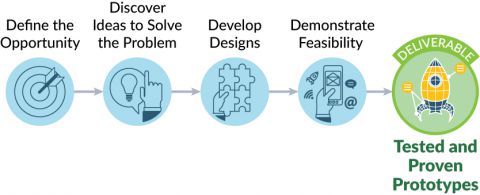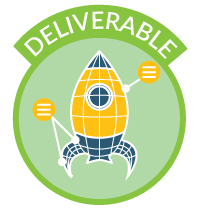Innovation: It Doesn’t Have to Be So Hard
With the staggering statistic that 80 percent of innovation efforts are unsuccessful, you may feel like innovation is a shot in the dark. But we know that when you apply a systematic, agile and repeatable process, you can flip those numbers and see an 80 percent SUCCESS RATE with innovation.
The Lean Methods Group’s holistic Innovation Lifecycle includes:
- The identification of what to innovate (Opportunity Exploration)
- Fast, iterative prototyping to ensure your ideas have traction with customers before spending a lot of time and money (Front End of Innovation)
- A linear stage-gate approach to perfect your solution designs (Back End Design)
- Commercialization or operationalization of final solutions
- You too can create a new product, service, process or business model using this lifecycle approach and guarantee a faster, less intimidating and less expensive innovation process that yields a higher probability of success.
This article showcases the Lean Methods Group’s Front End of Innovation and our D4 Methodology, which takes each opportunity identified through to proof of concept. D4 stands for:
- Define the Opportunity
- Discover Ideas to Solve the Problem
- Develop Designs
- Demonstrate Feasibility

Although phases are laid out linearly, in reality, this is an iterative process where teams experiment and quickly convert assumptions to knowledge prior to investing a lot of time or money in any one solution.
We use the D4 methodology to help teams identify and test the best solutions to meet specific customer and business needs and expectations. Here’s an overview of the D4 methodology and how it works to improve innovation success rates.
 DEFINE the Opportunity
DEFINE the Opportunity
Sometimes the very nature of innovation seems hazy and daunting, like sailing across a rough sea on a very cloudy, misty day. Those who know how to clear the haze and sail smoothly will see that innovation isn’t as elusive or difficult as it may seem. The Define phase enables you to identify the most important customer and business needs and expectations, providing a clear target on the horizon for your innovation journey.
In Define, we ensure opportunities are based on the customer perspective, not what you think the customer needs and wants.
We use the framework of the Job To Be Done (JTBD) to define customer needs and outcome expectations, gaps and high-potential innovation opportunities. This phase also uses qualitative research techniques, such as ethnography to directly observe how customers struggle with existing solutions so you can understand their unarticulated and emerging needs. Then, quantitative techniques are applied to validate your findings.
Some of the steps within Define include:
Establish Teams
Successful innovation projects arise from high performing and diverse innovation teams. You need a well-balanced cross-functional team that is able to provide multiple perspectives. The Lean Methods Group uses the most recent research from psychology and neuroscience to bring together, inspire and energize team members to build the collective intelligence required.
Identify the Job To Be Done
Customers hire products and services to get a job done. For example, you might “hire” fur-lined boots to keep warm in the winter. The JTBD is “keep feet warm while outside during winter months” and the solution hired is the “fur-lined boot”. But there are other ways to get that job done, like wearing insulated socks. The JTBD is the reason customers hire products and services and once known, provides the compass heading for the rest of the innovation lifecycle.
Extract Outcome Expectations and Identify Opportunities
Coupled with JTBDs are desired and undesired Outcome Expectations (OEs), or hiring criteria of the solution being developed. For example, you would be more apt to “hire” fur-lined boots as a solution if the boots met your hiring criteria: keep feet dry, look fashionable, not made of real fur and reasonably priced. The Outcome Expectations (OE) are from the customers’ perspective which requires qualitative research techniques such as ethnography, focus groups and interviews, along with survey methods to quantify importance and satisfaction.
 DISCOVER Ideas to Solve the Problems
DISCOVER Ideas to Solve the Problems
Successful innovation is about capitalizing on an opportunity to fulfill unmet customer expectations in a superior way. Finding that superior way typically requires thinking beyond our experience and education, and beyond our own industry. The prescription is to search knowledge bases that exist outside your self, finding clues and direction. One knowledge base is the problem-solving wisdom held by other industries and enterprises nearby or far removed from your own. Another is to explore the collective experience of all inventors through TRIZ (Theory of Inventive Problem Solving) techniques. Yet another is biomimicry, the study of adaptive miracles of nature and nonhuman species that have proven their survival resiliency for an astoundingly longer period of time than humans.
Your goal in Discover is to generate substantive ideas for closing outcome expectation gaps (or innovation opportunities) within the confines of a smartly scoped project. We help you explore and identify as many ideas as possible to meet the design challenge. We help you push for ideas beyond what you typically identify and expect, and help you remove any psychological inertia. Through the facilitated activities, you will also see the energy, creativity, motivation and confidence grow among your team.
This phase of the innovation ends by filtering and narrowing ideas down to the few that are the best candidates for further development and design.
Some of the steps within Discover include:
Establish the Ideal State Innovation
The new insights developed in the Define phase help convert assumptions to knowledge about what is really important to the customer and the business. These insights are then used in the Discover phase to help teams disassociate from any psychological inertia that exists in the organization and to define the ideal future state of the new solution.
Ideate and Discover
The innovation team comes together to consider the opportunity, imagine the ideal final state and discover new solution ideas. Idea generation is guided by working backwards from the imaginary ideal state to a practical future state. To inspire creative genius, we leverage a multitude of different techniques to stretch participants’ thinking past what is normally expected.
Group Ideas and Select Concepts
Ideation with a diverse team is a high-yield process—teams often generate hundreds, if not thousands, of solution ideas in a typical session. So in this convergent step, participants explore and understand all of the ideas proposed, and then group them into more implementable concepts. Concepts are then vetted against how well they address gaps in customer and business expectations.
 DEVELOP Designs
DEVELOP Designs
Most organizations go about refining their products and services—making them better—without first questioning their legitimacy. Instead we help you refine and bolster the best concepts so your ideas are robust and you have designs with some definition to test going forward. We help you prepare for rapid iterations of prototyping and customer feedback which will validate or invalidate known assumptions, uncover unknown assumptions and improve the solution design.
The Develop phase transforms your great ideas from the white board into workable models. The questions become:
- What functions will it perform and how do I design it?
- How will I assess how good it is?
- What alternatives do I have?
- Can I make my solution invincible, and manage the risk of trying?
Some of the steps within Develop include:
Identify Functions and Formulate Design
We help you transfer the core concept ideas into designs by asking questions about the functions and features required in the new process. We start by specifying the outcome-expectation-based functions your internal customers want in the new solution. During this stage, we also help you prioritize your ideas by filtering through a number of concepts to compare and contrast your ideas.
Strengthen and Optimize Your Designs
After focusing on two or three solution designs, it is time to improve and optimize each one. Some of the key questions to consider are: “What are different ways this design could fail?”, “How will we mistake-proof the designs?” and “What are the optimal levels for the design?” We help you refine and bolster each solution to ensure you have the best prototypes to be tested in Demonstrate.
Communicate and Sell Designs Internally
Innovation is similar to any other large change initiative. If you do not get people excited about and committed to your ideas, no matter how great your ideas are, the initiative will fail. We help you convey your ideas in compelling, visual ways that clearly describe your designs and how each one ties directly to needs and expectations, and do it in such a way that creates an emotional connection with your stakeholders.
 DEMONSTRATE Feasibility
DEMONSTRATE Feasibility
You are now ready to prove the solution designs are feasible before spending significant time and money perfecting any one solution, and even more importantly, assess if the proposed concept is truly indicative of the identified need and will be adopted in the market. This phase helps you continue to reduce the number of assumptions and builds on the advantages of Design Thinking, Rapid Prototyping, Agile Design and Human-Centered Design principles.
Some of the steps within Demonstrate include:
Develop Prototypes
Prototypes are generated for the solutions developed. Teams typically start with paper prototypes and progress to non-working and then working prototypes. But it is more than just the solution prototype itself. The Lean Methods Group helps ensure an experience-driven solution rather than simply a content- or technology-only-driven solution.
Pilot and Test
Demonstrating a solution may take many forms. To adequately gauge a customer’s response, nothing beats giving them something to hold, experience and emotionally connect with. Designs are tested rapidly with a select and representative group of customers. Feedback involves qualitative and quantitative research using ethnography, focus groups, interviews, surveys and statistical methods.
Prototyping or piloting may include two to five or more rounds and each test will generate information about the solution effectiveness and user experience which will be used to improve or optimize your solution.
After several iterations, your team will have optimized the solution design and developed significant knowledge about what will and will not work. At the end of the Demonstrate phase, designs have progressed through the process from ideas to deliverable prototypes. After a final review, these prototypes can be taken into the detailed Back End Design cycle to perfect your solutions and prepare them for full commercialization and implementation in your organization.
Deliverable: Tested and Proven Prototypes

At the end of D4, designs have gone from their inception to tested and proven prototypes.
By following the rapid yet systematic D4 Methodology, you will:
- Ensure the solutions you invest in have the highest probability of adoption when fully implemented.
- Push the creative boundaries beyond what you typically expect, and remove any psychological inertia in the organization.
- Minimize time and money to deliver the right solutions.
- Focus on the most important aspects of your solution based on in-depth customer ethnography and feedback.

